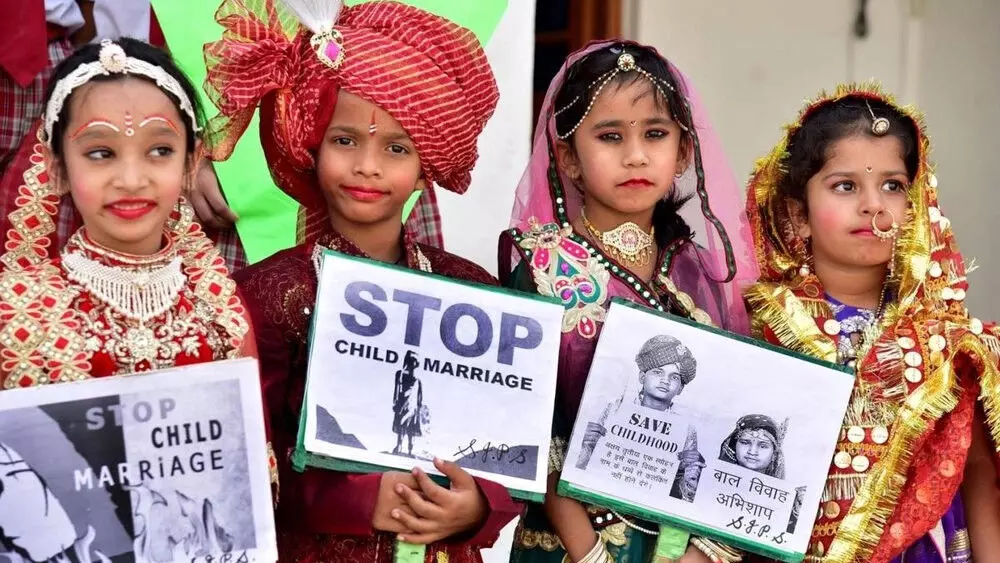NGOs Push for Policy Change:Free Education for All Can End Child Marriage by 2030

Free and compulsory education for all children under the age of 18 can play a pivotal role in ending child marriage as there is an inverse relationship between education and child marriage. For instance, in Kerala where the female literacy rate is as high as 96 percent, the prevalence of child marriage is as low as 6 percent as against the national average of 23.3 percent. Conversely, in states like Bihar, while the literacy rate of females is 61 percent, child marriage rate stands at a staggering 41 percent. This key finding, which could become a game-changer in the country’s fight against child marriage, is part of a research paper titled ‘Educate to End Child Marriage:
Exploring linkages and role of education in elevating age at marriage for girls in India’ released on International Women’s Day by Child Marriage Free India campaign which is a coalition of 160 NGOs. India, which is well on its way to reach tipping point to end this crime by 2030, can gain further momentum and direction if free and compulsory education becomes a reality, the report has found.
“While both the Centre as well as state governments have been exhibiting a tough stance to end child marriage, this one modification to the existing Right To Education to include all children up to the age of 18 could accelerate the pace to end child marriage and India can be child marriage free by 2030,” Jyoti Mathur, Director, Policy and Research, Child Marriage Free India, said. Notably, elimination of early, child and forced marriages by 2030 is also a global commitment by countries made under the aegis of United Nations Sustainable Development Goals (SDGs).
Child Marriage Free India campaign is a coalition of 160 NGOs across the country working in tandem with the government in over 300 districts witnessing a high prevalence of child marriage and aims to end this social crime by 2030 from the country. In the last six months alone, 50,000 child marriages have been stopped nationwide through counselling while legal action was initiated in around 10,000 child marriages. Releasing the paper, Child Marriage Free India campaign demanded that while the Centre and state government’s will and action to end this social crime is commendable and yielding results, firmer steps need to be taken to amplify this fight against child marriage. Drawing from insights revealed in the paper, the coalition asserted that the education of all children up to the age of 18 years be made free and compulsory and also urged all political parties to incorporate this important issue in their election manifestos for the upcoming Lok Sabha elections.
The research paper highlights the inverse relationship between female literacy rates and the prevalence of child marriage, citing examples from various regions across India. For instance, Mizoram shows a high female literacy rate of 93 percent and a relatively low child marriage prevalence of 8 percent.
Madhya Pradesh has a female literacy rate of 67.5 percent while the child marriage rate is 23.1 percent. Haryana, meanwhile, has a high literacy rate of 73.8 percent while the child marriage prevalence is 12.5 percent.
“As such, studies have shown that expanding access to education can significantly contribute to raising the age of marriage for girls, leading to positive socio-economic outcomes and improved gender equality,” the paper stated.
However, the paper further cites examples where this association seems weak such as in West Bengal which has a higher female literacy rate (77%) but still shows a high prevalence of child marriage at 42 percent. Similarly, in Tripura, while the literacy among females is 82 percent, the prevalence of child marriage stands high at 40 percent. Assam which has a literacy rate of 78.2 percent has the child marriage prevalence of 31.8 percent.
“These exceptions suggest that while female literacy rates may play a significant role, other socio-economic factors and cultural practices may also influence the prevalence of child marriage in these regions,” the paper added.
The last National Family Health Survey V (NHFS 2019-21) revealed that 23.3 percent of girls in the age group 20-24 were married before the age of 18 in the country. Meanwhile, Census 2011 reported that every 2 in 3 girls were married between 15-17 years of age, which meant that 33 lakh out of the 52 lakh girl children were pushed into marriage.
